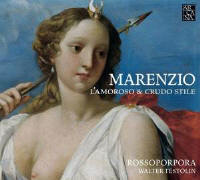Texte paru dans: / Appeared in: |
|
|
Outil de traduction ~ (Très approximatif) |
|
|
Reviewer: Barry
Brenesal
This is an interesting
collection of Marenzio’s madrigals, in large part because it demonstrates
that the accepted temporal dichotomy about the composer’s music—earlier
works from the first part of the 1580s, heavily contrapuntal, later works
from the late 1590s, heavily lyrical—doesn’t always hold. The opening pair
of madrigals, for instance, Come inanti de l’alba (First Book of Madrigals
in 6 Voices, 1581) and Qual vive Salamandra (First Book of Madrigals in 5
Voices, 1580), are largely homophonic, particularly the second; while the
concluding pair of works on the disc, the famous Solo e pensoso with its
chromatic half steps and Crudele, acerba, inexorabil morte (both from the
Ninth Book of Madrigals in 5 Voices, 1599), include a strong measure of
counterpoint via augmentation and imitation to create startling pictorial
effects.
For that corrective alone,
this album would possess some merit. The performances by Rossoporpora,
however, are excellent. Bertil van Boer wrote of their recording (with
Musicali Affetti) of Biagio Marini’s Madrigali & Symphonie (Tactus 591304;
Fanfare 41:5), that “the voices are clear and bright, and the tempos seem to
drive the music forward, as does the unambiguous diction….” As much can be
said of this release, with an added note to their ability, under Walter
Testolin’s direction, to reflect the many changes of color that Marenzio
applied through phrasing, counterpoint, harmonic shifts, and sudden shifts
of tempo and dynamics.
I wouldn’t, though,
characterize this ensemble’s approach to Marenzio’s madrigals as manneristic—a
term I would apply at times to the otherwise excellent La Venexiana under
Claudio Cavina’s inspired direction (Glossa 920906). Cavina’s version of
Solo e pensoso, for example, changes suddenly from its dragging pace used to
illustrate the opening pair of Petrarch’s lines to a sprint at the words,
“et gli occhi porto per fuggire intenti” (and with my eyes I’m running
away). By contrast, Rossoporpora only increases the tempo slightly, placing
more faith in the composer’s abrupt switch at that point to highly imitative
writing. The comparatively slower pace Testolin employs helps both clarify
the textures and increase the energy, as the five voices in separate entry
add better-defined density that drives the imagery home.
As for Rossoporpora (it means
reddish purple; no, really), on this album it’s a seven-voice choir (two
sopranos, altos, and tenors, with a bass), that has been directed since 2011
by Testolin. Fourteen of the 18 cuts include anywhere from four to six
voices; two others feature transcriptions performed by a pair of lutenists,
while another pair of selections include either one of the sopranos or the
bass with lutenists. Engineering is well balanced throughout, save in that
last couple of selections which display tonal issues due to recessing the
singers from the microphones. The other cuts are recorded closely and
effectively. With such fine performances, this disc makes an excellent first exposure to Marenzio’s richly expressive art. Recommended. | |
|
Support us financially by purchasing this disc from eiher one of these suppliers. Un achat via l'un ou l'autre des fournisseurs proposés contribue à défrayer les coûts d'exploitation de ce site. |
|
|
|
|
|
Cliquez l'un ou l'autre
bouton pour découvrir bien d'autres critiques de CD |
|




